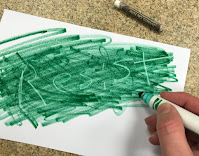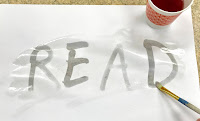For May's STEM program I decided to repeat a program I'd previously done in-person ("Spy School") with some tweaking to adapt it to a take-home kit plus video format, focusing only on the hidden and coded messages part and re-branding it as a Cryptography program. I chose this program because I knew it would be a little easier and less time-consuming to prep and a fairly short and quick video to record since I was going to be gone a week for vacation, and preparing for the summer was going to be hectic.
This program was intended for ages 6-12, and as the other STEM programs I've done lately was a hybrid program, with a take-home kit of supplies coupled with a video presentation.
Materials Provided In Kit:
- instructional brochure with general info, how to access the video, brief instructions for the activities, thought questions, where to find more info, and book suggestions.
- white crayon
- baking soda
- grape juice
- dixie cups
- cotton swabs
- DIY decoder
- brad fastener
- invisible ink pen
- substitution code practice sheets
- Pigpen Cipher practice sheet
- Greek square practice sheet
- final challenge worksheet
Additional Materials Needed:
- watercolor paints or washable marker (provided in supplemental, one-time family craft supply kit if needed)
- paper
- water
- paintbrushes
- milk
- hot iron (must have adult assistance)
- ironing board
Activity #1 - Hidden Messages
- Wax Resist - write a message with a white crayon, then color over it with watercolor paint or a water-soluble marker to reveal the message due to the hydrophobic properties of wax.
- Baking Soda - mix a tablespoon of baking soda with 1 to 2 tablespoons of warm water to make a saturated slurry. Use a cotton swab to write a message with this solution. Let dry, then reveal the hidden message by painting over with grape juice, which is acidic. The pigment in grape juice in pH sensitive and changes color in the presence of the baking soda.
- Milk - Write a message with a swab dipped in milk and let dry. Have an adult iron it with a very hot, dry iron to reveal the message using heat. This scorches the sugars and protein in the milk, turning the message tan-brown so it is visible. [The clichéd movie trick of using lemon juice and heating over a light bulb or simply by breathing on it does NOT work!]
- Invisible UV Reflective Ink - I splurged a little and bought these cool "spy pens" that have a UV-reflective ink that is completely invisible in normal light. The pens come with a tiny UV light to reveal the message.
Activity #2 - Secret Codes
For each code I gave them a sheet that explained how the code works and gave a one or two word example. Then they were asked to encode a few different words as practice, and decode a short message.
- Simple Substitution - This can be done several ways, but I gave them the simplest way as an example, numbering the letters of the alphabet starting with A as 1. Then you substitute the corresponding numbers for the letters, then vice versa to decode. I also showed how a number substitution would allow messaged to be hidden as math homework.
- DIY Decoder - I borrowed this simple DIY decoder wheel activity from "All for the Boys". I furnished it printed on cardstock, and they would simply have to cut out the three circles and assemble them centered on top of each other, and fasten with the included brad. This provides a quick and easy way to do multiple alphabet substitution codes.
- Greek Square Code - This is a more complicated number substitution code that assigns a 2-digit number to each letter of the alphabet using a 5x5 chart ("I" and "J" share a spot). The letters are then indicated by a pair of number coordinates, the number of the row first, then the number of the column. So the letter "A" is indicated by the number 11 (1st row, 1st column), and the letter "Z" is indicated by the number 55 (5th row, 5th column).
- Pigpen Cipher - This is my favorite, but a little tricky at first, and reportedly dates back to the Crusades. The letters are placed into a series of grids, with and without dots, and it is the lines of the grid around each letter that is used to substitute for the letter. The resulting coded messages make me think of alien hieroglyphics.
Activity #3 - Ultimate Challenge
For the challenge, I gave them a coded message that when decoded would tell them how to reveal the hidden message, which would also have to be decoded.
These were all done using codes and techniques covered, so they had everything needed to complete the challenge. I wrote the first message with an alphabet substitution code using the DIY decoder wheel, and gave them the hint that "A=D". When decoded, the first message says "ultraviolet light". This lets them know to use the UV light on their spy pens to reveal the hidden message I had written in UV reflective invisible ink using one of the pens. The hidden message was encoded using the Pigpen Cipher, and when decoded says "summer reading starts June first".
I closed by encouraging the audience to further explore the subjects of cryptography and espionage, and showed of few book suggestions, including an excellent book on the subject of codes and cyphers that I used in preparing for this program originally, Top Secret: A Handbook of Codes, Ciphers, and Secret Writing by Paul B. Janecszko (2004), as well as a book about Sioux code-talkers from WWII, a non-fiction book about the tools and techniques of espionage, the biography of a spy, and a fiction series (there was a more complete list in the included instructional brochure, as well).
How It Went
This worked really well for take & make kit, and was really inexpensive except for the spy pens. I wish I'd had the time and creative energy to make the messages they decoded a little more fun and somehow build on each other, but I was really pressed for time.
I was tempted to make one of the messages say "Be sure to drink your Ovaltine", but I figured few people would get the reference to poor Ralphie's disappointing coded message from the Little Orphan Annie radio show in the classic film A Christmas Story.
This will likely be the last take-home kit I do, at least for a while. The youth services department at the main library is doing centralized programming for the summer that will include a weekly animal program that is more "science-y" (as well as weekly storytime craft kits), so I am taking a break from planning take-home kits and focusing on outdoor, in-person programming for the summer, with the hope we will be able to return to normal indoor programming in the fall.
I may still occasionally do a take-home kit, or package any leftover supplies from in-person programs as take-home kits, but they won't be as elaborate as what I've done during the pandemic.
I was tempted to make one of the messages say "Be sure to drink your Ovaltine", but I figured few people would get the reference to poor Ralphie's disappointing coded message from the Little Orphan Annie radio show in the classic film A Christmas Story.
This will likely be the last take-home kit I do, at least for a while. The youth services department at the main library is doing centralized programming for the summer that will include a weekly animal program that is more "science-y" (as well as weekly storytime craft kits), so I am taking a break from planning take-home kits and focusing on outdoor, in-person programming for the summer, with the hope we will be able to return to normal indoor programming in the fall.
I may still occasionally do a take-home kit, or package any leftover supplies from in-person programs as take-home kits, but they won't be as elaborate as what I've done during the pandemic.










No comments:
Post a Comment